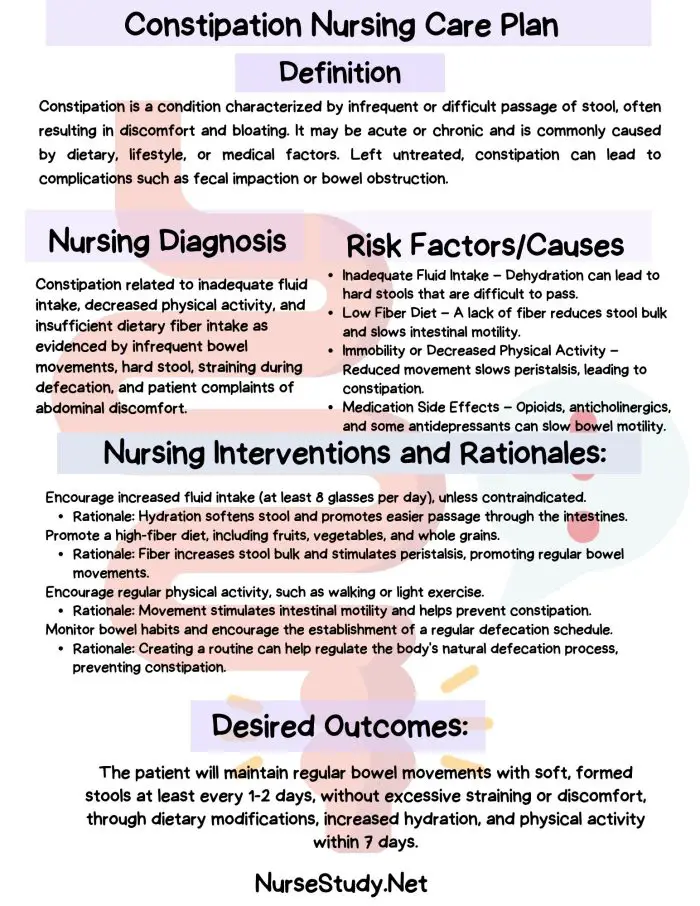Constipation is a common gastrointestinal issue that affects patients across various healthcare settings. It is characterized by infrequent bowel movements, difficulty passing stool, or the sensation of incomplete evacuation.
As a nursing diagnosis, constipation requires a holistic and individualized care plan to promote bowel health, prevent complications, and improve patient comfort.
Nursing Diagnosis: Constipation
Definition
According to NANDA International (NANDA-I), constipation is defined as a decrease in the frequency of defecation or difficulty in passing stool, which may include hardened stool or straining during bowel movements.
Etiology (Causes)
Constipation can arise due to various factors, which are typically categorized as primary or secondary causes:
- Primary Causes: Inadequate fiber intake, insufficient fluid intake, sedentary lifestyle, and voluntary suppression of the urge to defecate.
- Secondary Causes: Underlying medical conditions such as irritable bowel syndrome (IBS), medications (e.g., opioids, anticholinergics), or neurological conditions like Parkinson’s disease.
Defining Characteristics
A patient presenting with constipation may exhibit the following signs and symptoms:
- Infrequent or difficult bowel movements: Fewer than three bowel movements per week.
- Hard, dry stools: Increased stool consistency.
- Abdominal discomfort: Pain, bloating, or distension.
- Straining during defecation: Increased effort to pass stool.
- Sensation of incomplete evacuation: Persistent feeling that the bowel is not fully emptied.
- Increased flatulence: Excess gas in the digestive system.
Related Factors
The following factors may contribute to the development of constipation in patients:
- Dietary factors: Low intake of dietary fiber or fluids.
- Activity level: Limited mobility or prolonged bed rest.
- Medications: Use of opioids, antacids, antidepressants, and iron supplements.
- Psychological factors: Anxiety, stress, or depression.
- Neurological impairment: Conditions affecting nerve function in the gastrointestinal tract, such as multiple sclerosis.
Nursing Assessment
A thorough nursing assessment is critical in diagnosing constipation and formulating an effective care plan. Key aspects of the assessment include:
- Bowel History: Assess the patient’s usual bowel patterns, including frequency, stool consistency, and any changes.
- Dietary and Fluid Intake: Evaluate the patient’s intake of fiber-rich foods and fluids.
- Medications: Review the patient’s current medication regimen for drugs that may contribute to constipation.
- Activity Level: Assess the patient’s physical activity, particularly changes in mobility or exercise patterns.
- Psychosocial Factors: Explore any emotional or psychological stressors that may influence bowel habits.
Nursing Interventions and Rationales
- Promote Adequate Hydration
- Intervention: Encourage the patient to drink 2-3 liters of fluids per day, unless contraindicated.
- Rationale: Adequate hydration softens the stool, making it easier to pass through the intestines .
- Encourage a High-Fiber Diet
- Intervention: Advise the patient to consume 25-30 grams of dietary fiber daily, including fruits, vegetables, and whole grains.
- Rationale: Fiber adds bulk to stool and helps maintain regular bowel movements .
- Encourage Physical Activity
- Intervention: Promote regular exercise, such as walking or light aerobic activity.
- Rationale: Physical activity stimulates peristalsis, facilitating bowel motility .
- Administer Stool Softeners or Laxatives (as prescribed)
- Intervention: Administer medications like docusate sodium or osmotic laxatives when appropriate.
- Rationale: These agents soften stools and promote bowel movements by drawing water into the colon .
- Establish a Bowel Routine
- Intervention: Encourage the patient to attempt bowel movements at the same time each day, preferably after meals.
- Rationale: Establishing a routine can help regulate bowel function by utilizing the body’s natural gastrocolic reflex .
- Provide Education on Proper Defecation Position
- Intervention: Teach the patient to sit in a squatting position by raising their feet on a stool.
- Rationale: This position helps straighten the rectum, allowing easier passage of stool .
- Monitor for Complications
- Intervention: Regularly assess the patient for signs of fecal impaction or bowel obstruction.
- Rationale: Untreated constipation can lead to complications such as fecal impaction, hemorrhoids, or rectal prolapse .
Expected Outcomes
By implementing the appropriate interventions, patients should demonstrate the following outcomes:
- Increased Bowel Frequency: The patient will have at least one bowel movement every 1-3 days.
- Soft, Formed Stools: The patient will pass soft, formed stools without straining.
- Reduced Abdominal Discomfort: The patient will report decreased bloating, pain, and discomfort.
- Improved Fluid and Fiber Intake: The patient will meet daily fluid and dietary fiber intake goals.
References
- Emmanuel, A. V., & Quigley, E. M. (2017). Constipation in adults: Evaluation and management. American Journal of Gastroenterology, 112(5), 732-742. https://doi.org/10.1038/ajg.2017.60
- Suares, N. C., & Ford, A. C. (2011). Systematic review: The effects of fiber in the management of chronic idiopathic constipation. Alimentary Pharmacology & Therapeutics, 33(8), 895-901. https://doi.org/10.1111/j.1365-2036.2011.04602.x
- Rao, S. S. C., & Go, J. T. (2010). Update on the management of constipation in the elderly: New treatment options. Clinical Interventions in Aging, 5, 163-171. https://doi.org/10.2147/cia.s10909
- Müller-Lissner, S., et al. (2016). Clinical trial: The effect of docusate sodium in the management of chronic constipation. Journal of Gastroenterology and Hepatology, 31(4), 750-756. https://doi.org/10.1111/jgh.13164
- Dukas, L., Willett, W. C., & Giovannucci, E. L. (2003). Association between physical activity, fiber intake, and constipation in a study of women. American Journal of Gastroenterology, 98(8), 1790-1796. https://doi.org/10.1111/j.1572-0241.2003.07539.x
- Rao, S. S. C., & Rattanakovit, K. (2019). Defecation position: Fact or myth? Journal of Neurogastroenterology and Motility, 25(2), 147-152. https://doi.org/10.5056/jnm19001
- Tramonte, S. M., et al. (1997). The treatment of chronic constipation in adults: A systematic review. JAMA, 278(11), 989-994. https://doi.org/10.1001/jama.1997.03550110067041

